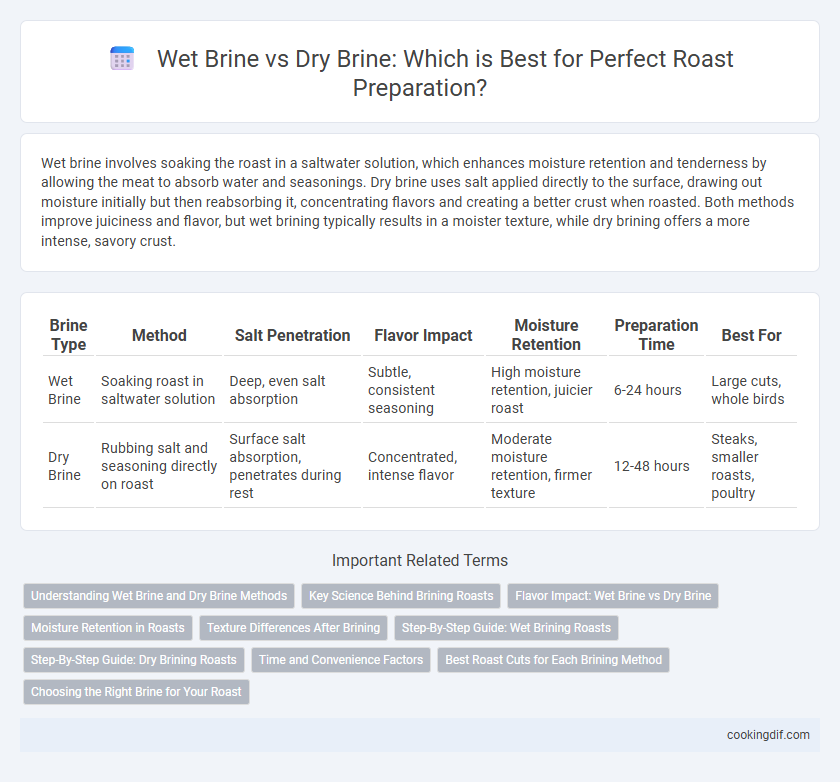Wet brine involves soaking the roast in a saltwater solution, which enhances moisture retention and tenderness by allowing the meat to absorb water and seasonings. Dry brine uses salt applied directly to the surface, drawing out moisture initially but then reabsorbing it, concentrating flavors and creating a better crust when roasted. Both methods improve juiciness and flavor, but wet brining typically results in a moister texture, while dry brining offers a more intense, savory crust.
Table of Comparison
| Brine Type | Method | Salt Penetration | Flavor Impact | Moisture Retention | Preparation Time | Best For |
|---|---|---|---|---|---|---|
| Wet Brine | Soaking roast in saltwater solution | Deep, even salt absorption | Subtle, consistent seasoning | High moisture retention, juicier roast | 6-24 hours | Large cuts, whole birds |
| Dry Brine | Rubbing salt and seasoning directly on roast | Surface salt absorption, penetrates during rest | Concentrated, intense flavor | Moderate moisture retention, firmer texture | 12-48 hours | Steaks, smaller roasts, poultry |
Understanding Wet Brine and Dry Brine Methods
Wet brine involves soaking the roast in a saltwater solution, enhancing moisture retention and flavor penetration through osmosis over several hours. Dry brine relies on rubbing salt directly onto the meat's surface, drawing out juices that are reabsorbed to create a concentrated, tender crust without added moisture. Both methods optimize seasoning and juiciness but differ in preparation time, texture, and impact on the roast's exterior.
Key Science Behind Brining Roasts
Wet brine involves submerging the roast in a saltwater solution, which uses osmosis and diffusion to enhance moisture retention and improve juiciness by allowing salt to penetrate deeply into muscle fibers. Dry brine, applying salt directly to the roast's surface, draws out moisture that then reabsorbs, concentrating flavors and tenderizing the meat through enzymatic activity. Both methods increase protein water-holding capacity and flavor profile by modifying muscle structure and promoting even seasoning throughout the roast.
Flavor Impact: Wet Brine vs Dry Brine
Wet brine enhances a roast's flavor by infusing moisture and salt throughout the meat, resulting in a juicier and more uniformly seasoned final product. Dry brine intensifies the natural taste by drawing out and then reabsorbing the meat's juices mixed with salt, creating a concentrated and deeply savory crust. Both methods improve flavor, but wet brining offers a subtle, consistent seasoning while dry brining provides a robust, caramelized outer layer.
Moisture Retention in Roasts
Wet brine enhances moisture retention in roasts by allowing the meat to absorb a saltwater solution, resulting in increased juiciness and tenderness during cooking. Dry brine draws out the meat's natural juices initially, which then reabsorb, intensifying flavor and preserving moisture more effectively without added liquid. Studies show that both methods improve retention compared to unbrined roasts, with wet brine offering more immediate moisture but dry brine providing a concentrated, flavorful result.
Texture Differences After Brining
Wet brine infuses the roast with moisture, resulting in a juicier and more tender texture due to the salt solution penetrating the meat fibers. Dry brine, by drawing out moisture and then reabsorbing it, creates a firmer texture with a more concentrated flavor and enhanced crust after roasting. The choice between wet and dry brining directly impacts the roast's final mouthfeel, balancing juiciness against surface crispness.
Step-By-Step Guide: Wet Brining Roasts
Wet brining roasts involves submerging the meat in a saltwater solution infused with aromatics like herbs, garlic, and spices for several hours to enhance moisture retention and flavor. Begin by dissolving kosher salt and sugar in cold water, then fully immerse the roast, refrigerating it based on weight--typically one hour per pound for optimal results. After brining, rinse the meat thoroughly, pat it dry, and allow it to rest uncovered in the refrigerator to develop a crispy, flavorful crust during roasting.
Step-By-Step Guide: Dry Brining Roasts
Dry brining roasts involves seasoning the meat with coarse salt and allowing it to rest uncovered in the refrigerator for 24 to 48 hours, which enhances flavor penetration and moisture retention. This step-by-step process begins with patting the roast dry, applying an even layer of salt and optional spices, then placing it on a rack to ensure air circulation. The dry brine forms a concentrated seasoning crust that improves the roast's texture and juiciness without the excess water typical of wet brining.
Time and Convenience Factors
Wet brine requires submerging the roast in a saltwater solution for 12 to 24 hours, which can extend preparation time and demands ample fridge space. Dry brine, using a salt rub applied directly to the meat, typically takes 24 to 48 hours but offers greater convenience by eliminating the need for a container and reducing mess. For quicker results with minimal cleanup, dry brining is often preferred, while wet brining suits those planning ahead with available refrigeration space.
Best Roast Cuts for Each Brining Method
Wet brine is ideal for lean cuts like turkey breast or pork loin, as it helps retain moisture and enhances tenderness during roasting. Dry brine works best for fattier cuts such as prime rib or whole chicken, intensifying flavor and creating a crispier crust. Choosing the appropriate brining method depends on the roast cut's fat content and desired texture for optimal results.
Choosing the Right Brine for Your Roast
Choosing the right brine for your roast depends on the desired texture and flavor intensity; wet brine involves soaking the meat in a saltwater solution, which enhances moisture retention and results in a juicier roast. Dry brine uses salt applied directly to the surface, promoting a concentrated, well-seasoned crust while preserving the meat's natural texture. Consider wet brine for larger, leaner cuts needing moisture and dry brine for smaller or fattier cuts where skin crispness and flavor depth are priorities.
Wet brine vs dry brine for roast preparation Infographic

 cookingdif.com
cookingdif.com